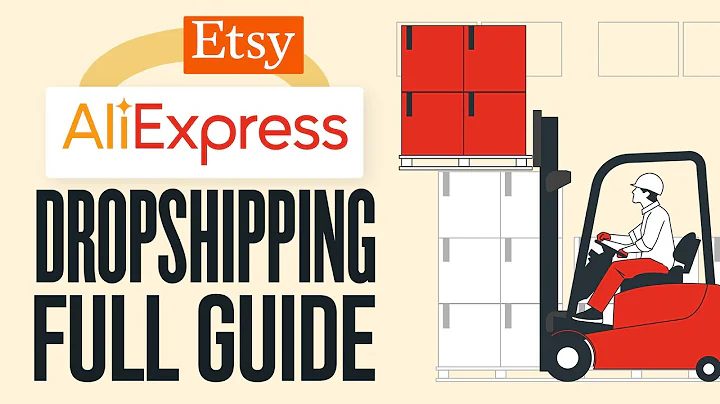Importing AliExpress Products to Shopify: A Step-by-Step Guide
Table of Contents:
- Introduction
- What is Drop Shipping?
- How Does Drop Shipping Work?
3.1 Finding Suppliers
3.2 Choosing Products to Sell
3.3 Setting Up an Online Store
3.4 Promoting and Marketing Products
3.5 Managing Orders and Inventory
- Advantages of Drop Shipping
4.1 Low Startup Costs
4.2 Wide Product Selection
4.3 Easy to Get Started
4.4 Location Flexibility
- Disadvantages of Drop Shipping
5.1 Lower Profit Margins
5.2 Dependency on Suppliers
5.3 Limited Control over Product Quality
5.4 Shipping Challenges
- Tips for Successful Drop Shipping
6.1 Research Products and Suppliers
6.2 Optimize Your Website
6.3 Provide Excellent Customer Service
6.4 Promote Your Business
- Is Drop Shipping Right for You?
- Conclusion
Title: Drop Shipping: A Comprehensive Guide to Building a Successful Online Business
Drop shipping has become increasingly popular as a business model for aspiring entrepreneurs. With its low startup costs and flexibility, it offers a convenient way to start an online business without the need for inventory or upfront investment. In this comprehensive guide, we will walk you through the process of setting up and running a successful drop shipping business. From understanding the basics to mastering advanced strategies, we will provide you with all the information you need to thrive in this competitive industry.
Introduction
In today's digital age, starting an online business has become a popular and accessible option for entrepreneurs. Among the various e-commerce business models, drop shipping has gained significant traction due to its ease of implementation and low startup costs. By partnering with suppliers who handle inventory and shipping, drop shipping allows entrepreneurs to focus on marketing and customer service, making it an attractive option for those looking to venture into the e-commerce space.
What is Drop Shipping?
Drop shipping is a fulfillment method in which an online retailer does not keep products in stock but instead transfers the customer's orders and shipment details to the supplier, who then ships the products directly to the customer. Essentially, the retailer acts as a middleman, facilitating the sale while relying on the supplier to handle inventory management and order fulfillment.
How Does Drop Shipping Work?
3.1 Finding Suppliers
One of the first steps in starting a drop shipping business is finding reliable suppliers. Quality suppliers are crucial as they directly impact the customer experience and the success of your business. To find suppliers, you can use online marketplaces and directories, attend industry trade shows, or reach out to manufacturers directly.
3.2 Choosing Products to Sell
Once you have established relationships with suppliers, the next step is to choose the products you want to sell. It is essential to conduct market research and identify profitable niches with a high demand for products. Consider factors such as product quality, pricing, and shipping costs when selecting products for your store.
3.3 Setting Up an Online Store
To run a drop shipping business, you will need a platform to sell your products. Setting up an online store is a crucial step in establishing your brand and creating a seamless shopping experience for your customers. Choose a user-friendly e-commerce platform and design a visually appealing website that showcases your products effectively.
3.4 Promoting and Marketing Products
Once your store is up and running, it's time to promote your products and attract customers. Implement various marketing strategies such as search engine optimization (SEO), social media marketing, email marketing, and content marketing to increase your brand visibility and drive traffic to your store.
3.5 Managing Orders and Inventory
As orders start coming in, you need to manage them efficiently to ensure a seamless customer experience. Automate order processing as much as possible and stay in constant communication with your suppliers to ensure timely and accurate order fulfillment. Additionally, keep track of your inventory to avoid overselling or running out of stock.
Advantages of Drop Shipping
4.1 Low Startup Costs
One of the major advantages of drop shipping is its low startup costs. You don't have to invest in inventory or warehouse space, reducing the financial risk associated with starting a traditional retail business. This allows you to allocate your resources towards marketing and growing your business.
4.2 Wide Product Selection
With drop shipping, you have access to a wide range of products from various suppliers. This allows you to offer a diverse catalog and cater to different customer preferences without the need for upfront inventory investment.
4.3 Easy to Get Started
Compared to starting a brick-and-mortar store, setting up a drop shipping business is relatively easy. With the right tools and a well-designed website, you can have your online store up and running within a short period.
4.4 Location Flexibility
Since you don't have to handle physical inventory, you can manage your drop shipping business from anywhere in the world. This provides you with the freedom and flexibility to work remotely or even travel while running your business.
Disadvantages of Drop Shipping
5.1 Lower Profit Margins
While drop shipping offers low startup costs, it also tends to have lower profit margins compared to traditional retail. With numerous competitors and the ease of market entry, pricing becomes highly competitive, limiting the potential for higher profits.
5.2 Dependency on Suppliers
As a drop shipping retailer, you rely heavily on your suppliers for inventory management and order fulfillment. If a supplier fails to deliver on time or runs out of stock, it directly impacts your business's reputation and customer satisfaction.
5.3 Limited Control over Product Quality
Since you are not responsible for product quality control and shipping, you have limited control over the entire fulfillment process. This could result in instances where customers receive damaged products or experience delayed shipments, reflecting negatively on your brand.
5.4 Shipping Challenges
As a drop shipper, you may face challenges related to shipping, especially if you work with multiple suppliers located in different regions. Coordinating and consolidating shipments can be complex and may lead to increased shipping costs and longer delivery times.
Tips for Successful Drop Shipping
6.1 Research Products and Suppliers
Thoroughly research and vet potential products and suppliers before partnering with them. Ensure the products meet high-quality standards, and suppliers have a proven track record of reliability and good customer service.
6.2 Optimize Your Website
Invest time and effort into optimizing your website for conversions. Create compelling product descriptions, high-quality images, and an intuitive user interface that encourages visitors to make a purchase.
6.3 Provide Excellent Customer Service
Since customer satisfaction is crucial for success, prioritize exceptional customer service. Respond to inquiries promptly, resolve issues efficiently, and go the extra mile to exceed customer expectations.
6.4 Promote Your Business
Implement various marketing strategies to promote your drop shipping business. Utilize social media platforms, content marketing, and paid advertising to reach your target audience and drive traffic to your store.
Is Drop Shipping Right for You?
Deciding whether drop shipping is the right business model for you depends on various factors, including your goals, resources, and commitment. Evaluate the advantages and disadvantages discussed in this guide and consider if they align with your entrepreneurial aspirations.
Conclusion
Drop shipping offers an enticing opportunity for aspiring entrepreneurs to start an online business with minimal investment. By leveraging the benefits of low startup costs, wide product selection, and location flexibility, individuals can create a profitable venture in the e-commerce industry. However, it is essential to navigate the challenges of lower profit margins and supplier dependency to establish a successful drop shipping business. With the right strategies, research, and dedication, drop shipping can be a lucrative business model for those willing to put in the effort.















